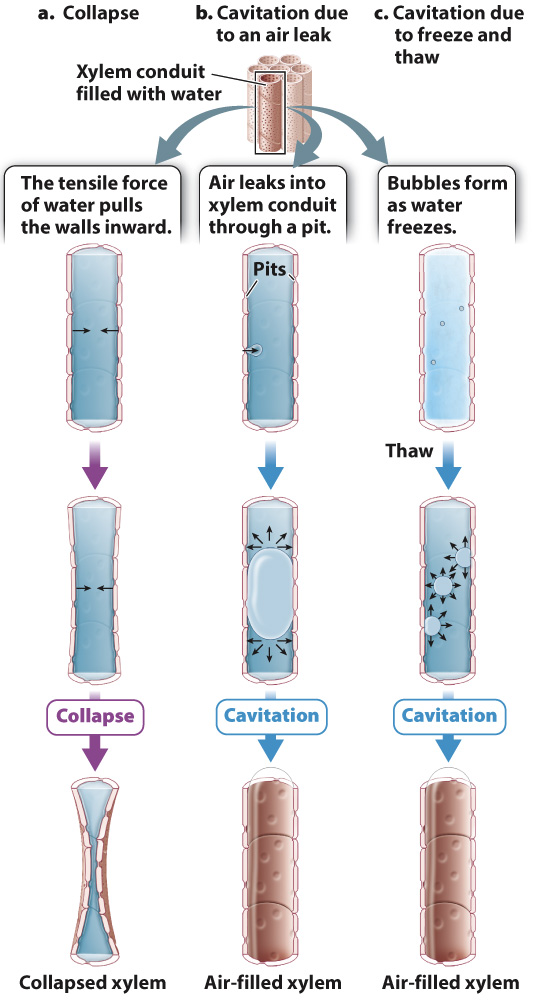Xylem transport is at risk of conduit collapse and cavitation.
610

Water can be pulled through the xylem only if there is a continuous column of water that extends from the roots to the leaves. Thus, xylem conduits must be structured in such a way as to minimize two distinct risks (Fig. 29.13). The first is the danger of collapse. If you suck too hard on a drinking straw, it will collapse inward, blocking flow. Much the same thing can happen in xylem (Fig. 29.13a). To prevent this, xylem has thick walls that contain lignin. Although in metabolic terms lignin is more costly to produce than cellulose, lignin makes conduit walls rigid, reducing the risk of collapse.
The second danger associated with pulling water through the xylem is cavitation, the abrupt replacement of water by water vapor. Because cavitation disrupts the continuity of the water column, cavitated conduits can no longer transport water from the soil. Cavitation can occur in either of two ways. First, an air bubble may be pulled through a pit because of lower pressure in the water compared to the air (Fig. 29.13b). The bubble can then expand under the tensile, or pulling, force exerted by leaves. The likelihood of cavitation forming in this way increases during drought, when the tensions in the xylem are large.
The second way that cavitation occurs in xylem conduits is by gases coming out of solution during freezing (Fig. 29.13c). Gases are much less soluble in ice than in water, so as a conduit freezes, dissolved gas molecules aggregate into tiny bubbles that can cause cavitation when the conduit thaws. The wide vessels found in angiosperms are especially vulnerable to cavitation at freezing temperatures, partly explaining why boreal (that is, subarctic) forests contain few angiosperms.
The xylem is organized in ways that minimize the impact of cavitation. For example, xylem consists of many conduits in parallel, so the loss of any one conduit to cavitation does not result in a major loss of transport capacity. Similarly, as water flows from the soil to the leaves, it passes from one conduit to another, each one of finite length. The likelihood that cavitation will spread is thereby reduced because air can be pulled through pits only when the tensile forces in the xylem are large.
Quick Check 3 How is the statement that water is transported through the xylem without requiring any input in energy by the plant both correct and incorrect?
Quick Check 3 Answer
The statement is correct in that the force that pulls water from the soil results from the evaporation of water from leaf cells, the energy for which comes from the heating of the leaf by the sun. It is incorrect in that there are structures within the plant that make water transport possible, notably the xylem conduits, and also the roots and the stem. The plant must expend energy to produce all these structures.